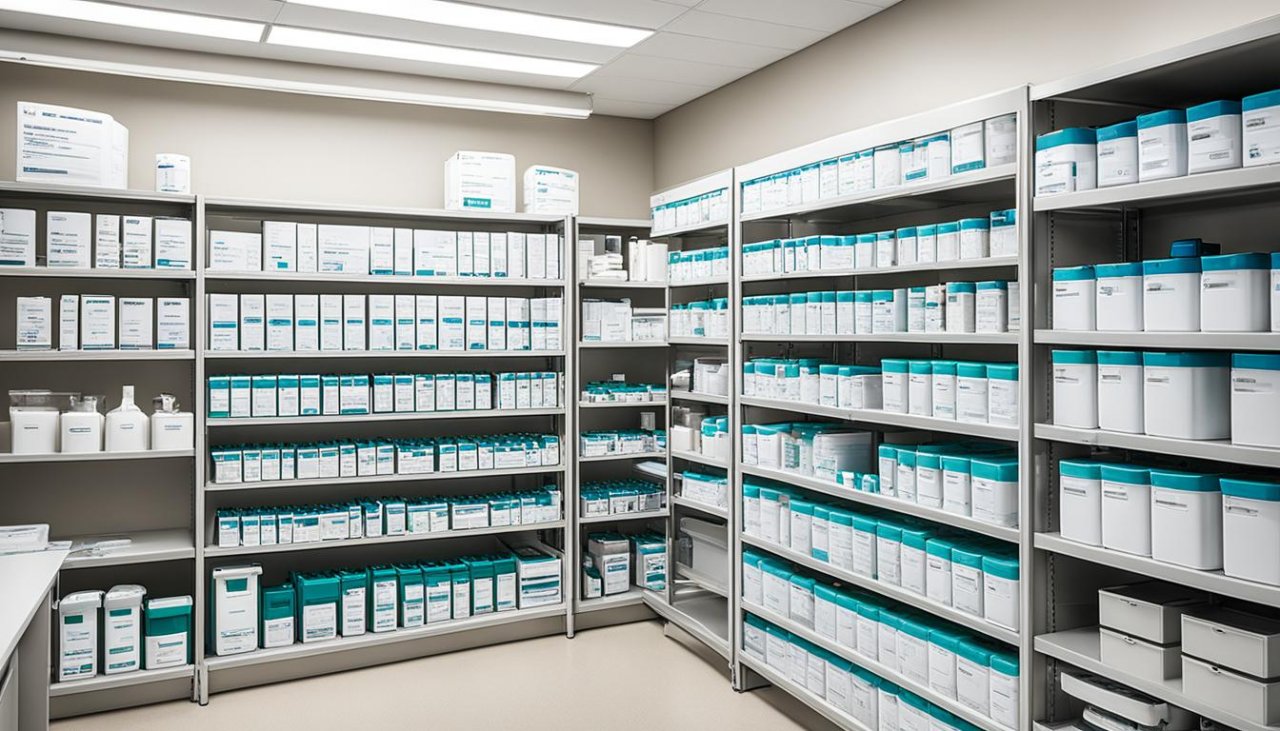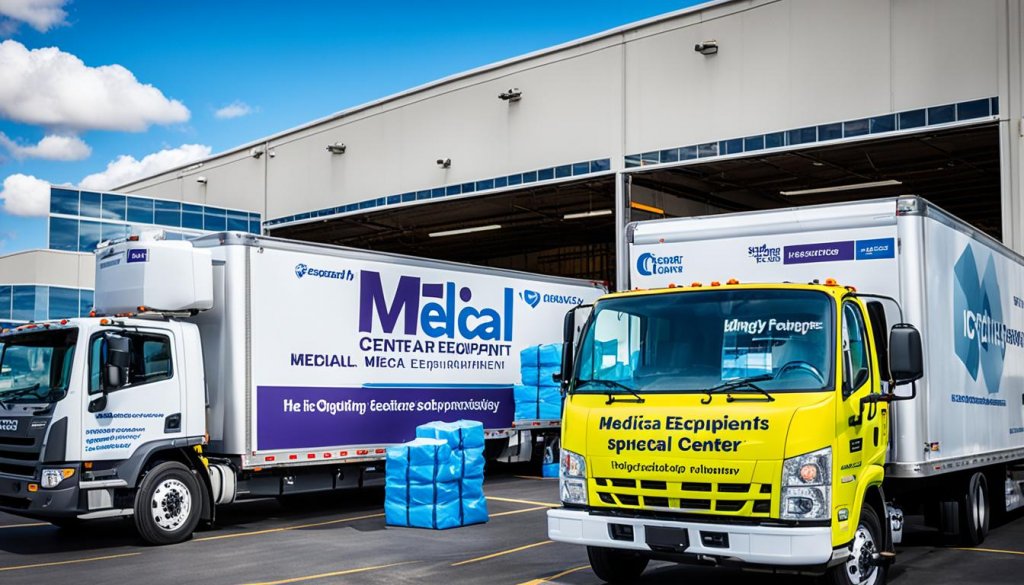Shipping and logistics play a crucial role in the success of a medical equipment business. Whether you are dealing with healthcare technology, medical devices, hospital supplies, diagnostic tools, surgical instruments, patient monitoring systems, medical imaging equipment, rehabilitative aids, or laboratory instruments, it is essential to follow best practices to ensure safe and timely delivery.
Let me share a story to emphasize the importance of proper shipping and logistics in the medical equipment industry:
Dr. Johnson is a renowned surgeon who relies heavily on cutting-edge medical equipment to perform complex surgeries. One day, he received a call from a patient in urgent need of surgery. The operation required a specialized surgical instrument, which was located in a different city. Dr. Johnson knew that time was of the essence, and the instrument needed to arrive quickly and in perfect condition.
He immediately contacted a logistics provider that specialized in medical equipment shipping. The provider assured him that they were experienced and equipped to handle delicate medical instruments. They understood the importance of maintaining the instrument’s integrity during transit, including temperature control and proper handling to avoid damage.
The logistics provider promptly arranged for the instrument to be picked up and carefully packaged using industry best practices. They ensured that it was stored at the required temperature and protected from moisture and vibrations. With real-time tracking and monitoring systems in place, Dr. Johnson could follow the instrument’s journey and receive updates on its location and condition.
Thanks to the expertise and reliability of the logistics provider, the surgical instrument arrived at Dr. Johnson’s hospital precisely when he needed it. The successful operation was a testament to the careful planning, adherence to regulations, and attention to detail in the shipping and logistics process.

Key Takeaways:
- Proper shipping and logistics are essential to ensure safe and timely delivery of medical equipment.
- Adhering to regulations and best practices is crucial in maintaining the integrity of medical equipment during transit.
- Real-time tracking and monitoring systems provide visibility and ensure the safety and security of medical supplies.
- Choosing a reliable logistics provider that specializes in medical equipment shipping is paramount.
- Investing in quality transportation equipment and staying updated on industry developments are practical steps to excel in delivering medical supplies.
Now that we understand the importance of shipping and logistics in the medical equipment industry, let’s explore the best practices in more detail.
Importance of Properly Storing Medical Equipment
Properly storing medical equipment is crucial for maintaining its quality, ensuring its functionality, and prolonging its lifespan. Whether it’s large imaging systems, surgical devices, lab equipment, or other fragile items, the way we store these assets plays a significant role in their efficacy and reliability.
When it comes to medical equipment logistics, attention to storage conditions is essential. Medical devices are regulated by the FDA, and strict regulations govern the handling of drugs and medications. To comply with these regulations, warehouses storing medical equipment and pharmaceutical products must meet certain standards.
Firstly, cleanliness is paramount. Warehouses and storage facilities must be kept clean, free of pests, and regularly sanitized to prevent contamination. This ensures that the equipment remains in a sterile and hygienic environment, ready for use when needed.
Secondly, security is crucial. Medical equipment is valuable and prone to theft, which can disrupt patient care and lead to financial losses. Therefore, warehouses must have robust security measures in place to deter theft and break-ins. This includes restricted access, surveillance systems, and secure storage solutions.
Moreover, temperature-controlled settings are essential for storing certain medical devices and pharmaceuticals. Many drugs and medications are sensitive to temperature fluctuations and require specific storage conditions to maintain their effectiveness. By ensuring that the storage facilities are climate-controlled and equipped with backup power, healthcare providers can safeguard the quality of these products.
In addition, implementing tracking systems for expiration dates of medical supplies is crucial. This helps prevent wastage by ensuring that expired items are identified and removed from inventory promptly. By maintaining accurate records and managing inventory effectively, healthcare providers can optimize their supply chain and reduce unnecessary expenses.
Overall, properly storing medical equipment is vital to ensure the safety, integrity, and efficacy of these valuable assets. By adhering to proper storage practices, healthcare providers can reduce the risk of errors, improve patient care, and optimize their operations.
Importance of Properly Shipping Medical Equipment
When it comes to shipping medical equipment, ensuring proper handling and transportation is essential to protect these valuable assets. As a medical equipment logistics company with 25 years in business and a track record of delivering over 1.5 million shipments, we understand the importance of maintaining the integrity of medical devices throughout the shipping process.
One of the key factors to consider when shipping medical equipment is the environment. Moisture, temperature, and vibrations can all have a significant impact on the condition of medical devices. That’s why we take extra precautions to create an optimal shipping environment that minimizes the risk of damage.
Proper packaging plays a critical role in protecting medical equipment from any potential harm during transit. We follow specific recommendations to ensure that each item is securely packaged in strong and durable boxes. Additional protective measures such as bubble wrap and foam padding are used to safeguard delicate devices from any impact-related damage.
Correct labeling is also paramount in the shipping process. We make sure that each package is clearly labeled with detailed recipient information, return address, and any special handling instructions. This helps to avoid any confusion and ensures that the medical equipment reaches its intended destination safely and on time.
Furthermore, compliance with rules and regulations is of utmost importance when shipping medical equipment. Depending on the nature of the shipment and its destination, there may be specific permits or documents required for international shipments. Our experienced team is well-versed in the necessary procedures, ensuring that all legal requirements are met for a smooth and hassle-free shipping experience.
Specialized medical equipment, including MRI machines, CT scanners, surgical devices, and lasers, often require tailored packaging due to their fragility and unique handling requirements. Our expertise in medical equipment logistics allows us to provide customized solutions that address the specific needs of each device, minimizing the risk of damage during transportation.
Insurance and tracking are crucial elements in the shipping of expensive medical equipment and supplies. By safeguarding investments and ensuring careful handling from pickup to delivery, our comprehensive insurance coverage provides peace of mind to our customers. Additionally, our advanced tracking technology allows for real-time monitoring, enabling us to provide end-to-end visibility throughout the shipping process.
Properly shipping medical equipment is not only important for maintaining the condition of these valuable assets; it also has direct implications for patient diagnosis and treatment. Delays or damage in the shipment process can directly impact the ability of hospitals and medical equipment manufacturers to provide timely medical care. By prioritizing proper shipping practices, we contribute to the overall efficiency and effectiveness of the healthcare system.
Efficiency of Healthcare Logistics
The importance of properly shipping medical equipment extends beyond the individual shipment. In the context of the healthcare industry, efficient logistics is crucial to reduce costs and optimize operations. According to the Centers for Medicare and Medicaid Services, U.S. national healthcare costs reached a staggering $4.3 trillion in 2021. A significant portion of these costs, approximately $760 billion to $1.14 trillion, is attributed to healthcare supply chain expenses.
Hospitals, in particular, face the challenge of managing pharmaceuticals, medical devices, and consumables for over 7,000 facilities. Inefficient supply chain practices result in an annual waste of $25.4 billion for hospitals alone. By outsourcing shipping, warehousing, and inventory management processes, organizations can reduce staffing and capital expenses, allowing them to allocate resources where they are most needed: the provision of top-quality care to patients.
Partnering with a trusted medical equipment logistics company not only offers tangible cost savings but also grants access to specialized knowledge and expertise. Accredited certifications like ISO 13485, Good Distribution Practice (GDP) for medical devices, and Hazardous Materials Transportation (HMT) certification ensure compliance with regulatory standards such as 21 CFR Part 820 (FDA) and EU MDR/IVDR (E.U.).
Outsourcing healthcare logistics has numerous benefits, including end-to-end visibility, reverse logistics services, and access to cutting-edge technology. Digitalization, automation, and real-time tracking are just a few of the trends shaping the healthcare logistics landscape. By staying at the forefront of these developments, we continuously provide our clients with efficient and reliable shipping solutions tailored to their unique needs.
Steps in the Medical Equipment Logistics Process to Ensure Safe Shipping
When it comes to shipping medical equipment, a well-executed logistics process is crucial to ensure safe and efficient delivery. Here are the key steps involved:
Think and Plan Ahead
Before shipping medical equipment, it’s essential to think and plan ahead to avoid any potential issues. Consider the specific requirements of each piece of equipment, such as temperature and environmental concerns, and ensure that the shipping method and packaging can adequately protect them. By proactively addressing these factors, you can minimize the risk of damage during transit.
Identify Hazardous Materials
Some medical equipment may contain hazardous materials that require special handling and shipping considerations. It is important to identify any hazardous materials present and comply with regulations to ensure proper packaging and transportation. This includes following guidelines set by organizations like the U.S. Department of Transportation and the Environmental Protection Agency to meet safety standards and prevent any environmental risks.
Custom Packaging
Custom packaging plays a vital role in ensuring the safe delivery of medical equipment. Each piece of equipment must be carefully packaged using suitable materials that provide adequate protection against vibrations, shocks, and temperature changes. Custom-built crates and specific packaging solutions are often necessary to safeguard fragile or sensitive equipment during transportation.
Disassemble Items
In some cases, it may be necessary to disassemble certain medical equipment before shipping to ensure safe transport. This step helps reduce the risk of damage during transit and allows for more efficient packaging. Carefully follow manufacturer guidelines and consider seeking professional assistance if needed to guarantee proper disassembly and reassembly of the equipment.
Tracking Shipments
Tracking shipments is crucial to ensure visibility and accountability throughout the shipping process. By utilizing tracking systems provided by shipping companies, you can monitor the progress of your medical equipment shipments in real-time. This allows you to identify any potential delays or issues and take proactive measures to address them promptly.
Implementing these steps in the medical equipment logistics process will help ensure safe shipping from start to finish. By thinking ahead, addressing temperature and environmental concerns, identifying hazardous materials, using custom packaging, disassembling items if necessary, and tracking shipments, you can minimize risks and achieve successful delivery of your valuable medical equipment.
Finding a 3PL for Medical Equipment Shipping Services
When it comes to shipping medical equipment, partnering with a third-party logistics provider (3PL) specializing in healthcare logistics can greatly benefit your business. Not only can a reputable 3PL streamline your shipping processes, but they also offer expertise and resources that ensure the safe and efficient transportation of your valuable medical equipment.
When searching for the right 3PL for your medical equipment shipping needs, there are several qualifications and considerations to keep in mind.
FDA-Registered and cGMP Compliant
First and foremost, it is crucial to select a 3PL that is FDA-registered and cGMP compliant. These certifications demonstrate that the provider meets the rigorous standards set by the Food and Drug Administration (FDA) to ensure the safety and quality of medical devices. By choosing an FDA-registered 3PL, you can have peace of mind knowing that your medical equipment will be handled in accordance with industry regulations.
HAZMAT Certifications
Medical equipment shipping often involves the transportation of hazardous materials. It is imperative to partner with a 3PL that possesses the necessary HAZMAT certifications. These certifications signify that the provider has the knowledge and capabilities to handle and transport hazardous materials safely, minimizing the risk of accidents or incidents during transit.
Advanced Tracking Capabilities
Tracking the whereabouts of your medical equipment during shipping is essential for visibility and peace of mind. Look for a 3PL that offers advanced tracking capabilities, allowing you to monitor your shipments in real-time. Whether it’s through an online portal or mobile app, reliable tracking provides you with valuable information and ensures that your medical equipment arrives at its destination on time and intact.
![]()
By partnering with a 3PL that meets these qualifications, you can trust that your medical equipment will be handled with care and transported securely. Don’t compromise on the safety and efficiency of your shipping processes – choose a reputable 3PL for your medical equipment shipping services.
Certifications and Qualifications for Shipping Medical Equipment
When it comes to shipping medical equipment, ensuring compliance with regulations and industry standards is of utmost importance. This requires obtaining the necessary certifications and qualifications to guarantee the safe and secure transportation of these vital supplies.
One crucial certification is being FDA-registered, which demonstrates that the shipping process adheres to the rigorous standards set by the Food and Drug Administration. Additionally, being cGMP compliant ensures that the shipping procedures meet the Current Good Manufacturing Practice guidelines, further ensuring the integrity and quality of the equipment.
Another vital qualification is HAZMAT certifications, which are necessary when handling and transporting hazardous materials commonly found in medical equipment. These certifications ensure that proper precautions are taken to prevent any potential risks during transit.
Shipping qualifications encompass a range of factors that contribute to a successful and secure shipment. These include implementing quarantine procedures to prevent cross-contamination, utilizing temperature-controlled facilities to preserve the integrity of sensitive equipment, and employing proper handling techniques to minimize the risk of damage.
Effective inventory management is also crucial to shipping medical equipment. This involves accurately tracking and documenting the equipment throughout the shipping process to ensure nothing gets lost or misplaced.
Regular inspections are essential to guarantee compliance with regulations and identify any issues that may compromise the safety or efficiency of the shipping process. By conducting thorough inspections, any potential problems can be addressed promptly, ensuring the smooth delivery of important medical supplies.
The Importance of Proper Qualifications and Certifications
Obtaining the necessary certifications and qualifications for shipping medical equipment is vital for several reasons. Firstly, it ensures that the shipping process aligns with the highest standards of quality and safety.
Secondly, it protects the reputation of your business. Having the proper certifications and qualifications demonstrates your commitment to excellence and instills confidence in your customers, assuring them that their medical equipment is in capable hands.
Moreover, being certified and qualified provides a competitive advantage in the market. It shows that your business is equipped to handle the specialized requirements of shipping medical equipment, setting you apart from competitors.
Lastly, maintaining up-to-date certifications and qualifications is crucial to staying relevant in this ever-evolving industry. Ongoing education and training ensure that you are well-informed about the latest regulations and best practices, enabling you to provide the highest level of service to your customers.
By prioritizing certifications and qualifications, you can establish yourself as a trusted and reliable partner for shipping medical equipment, meeting the stringent requirements of the healthcare industry.
Packaging Requirements for Medical Equipment
When it comes to shipping and transporting medical equipment, proper packaging is essential to ensure the safety and integrity of the items. Medical equipment packaging must adhere to specific requirements set by regulatory bodies to maintain sterility, functionality, and compliance with industry standards.
One crucial regulation to consider is 21 CFR Part 820, which outlines the Quality System Regulation (QSR) requirements by the FDA for medical device packaging validation. Additionally, ISO 11607, which comprises ISO 11607-1 and ISO 11607-2, provides guidelines for packaging terminally sterilized medical devices.
FDA regulations in sections such as 820.30 and 820.120 address validation and documentation requirements for medical device packaging, emphasizing the importance of proper validation processes and thorough documentation.
Compliance with ISO 11607 standards is considered crucial to meet regulatory expectations and adhere to good manufacturing practices. Several regulatory bodies worldwide, such as the European Union Medical Device Regulation (EU MDR), Health Canada, Therapeutic Goods Administration (TGA) in Australia, and the Pharmaceuticals and Medical Devices Agency (PMDA) in Japan, enforce specific requirements for medical device packaging validation.
Medical equipment packaging materials must provide an effective barrier against moisture, oxygen, light, and contaminants to preserve device sterility, stability, and functionality. Temperature-controlled packaging may be necessary to maintain the integrity of fragile and sensitive equipment.
In terms of design, custom packaging should be used to provide adequate protection during shipping. This includes the use of shipping containers and implementing proper blocking and bracing techniques to minimize movement and ensure the equipment remains secure throughout transit.
Furthermore, tamper-evident features in medical device packaging are essential for ensuring integrity and safety by indicating any unauthorized opening. Proper labeling on packaging is crucial and should include device identification, intended use, lot number, expiration date, and handling/storage instructions.
Throughout the packaging process, validation plays a critical role. Packaging validation involves testing the ability of the packaging to maintain sterility during the sterilization process and throughout the shelf life of the equipment.
By adhering to these packaging requirements, medical equipment can be shipped safely and securely, protecting the integrity of the items and ensuring compliance with regulatory standards.
Shipping Requirements for Medical Equipment
When it comes to shipping medical equipment, there are specific requirements that must be followed to ensure the safe and efficient delivery of these valuable and often sensitive items. Whether you are shipping medical devices, supplies, or equipment, it is important to understand the regulations and guidelines that govern the transportation process.
One key consideration is temperature control. Many medical devices and supplies require specific temperature conditions to maintain their integrity and effectiveness. Proper packaging and shipping methods must be employed to keep these items within the recommended temperature range throughout the transportation journey.
In some cases, expedited shipments may be necessary, especially for time-critical situations where medical equipment needs to reach its destination quickly. Whether it’s a life-saving device or essential supplies, expedited shipping ensures prompt delivery, reducing the risk of delays that could impact patient care.
Direct delivery is another important aspect of medical equipment shipping. Direct delivery means that the equipment is shipped directly from the supplier or manufacturer to the end user, such as a healthcare facility or medical professional. This ensures a streamlined and reliable process, minimizing the handling of the equipment and reducing the risk of damage or loss during transit.
In certain circumstances, a white glove service may be available for medical equipment shipping. This premium service goes beyond traditional delivery methods by providing additional support in unpacking, positioning, and even assembling the medical equipment. This specialized service ensures that the equipment is properly set up and ready for immediate use.
Meeting medical equipment shipping requirements is essential to ensure the safe and timely delivery of these critical items. Adhering to temperature control guidelines, considering expedited shipments when necessary, opting for direct delivery, and exploring the possibility of a white glove service can all contribute to a smooth and reliable shipping process.

Ensuring Compliance and Safety
In order to comply with shipping regulations and maintain the safety of medical equipment, it is important to document and track the packaging and shipping processes. This documentation serves as evidence of compliance, enables traceability, and facilitates audit purposes. Additionally, it is crucial to partner with reputable companies that specialize in medical equipment shipping and offer expertise in adhering to FDA and ISO standards.
By following the necessary shipping requirements and working with trusted partners, you can ensure the safe and efficient transportation of medical equipment, protecting the valuable devices and supplies that play a crucial role in patient care.
Handling Hazardous Materials in Medical Equipment Shipping
When it comes to shipping medical equipment, it’s essential to understand and comply with the regulations surrounding hazardous materials. Some medical equipment may contain hazardous materials that require special handling to ensure the safety of personnel, the public, and the environment.
Compliance and Safety Regulations
In the United States, hazardous materials regulations cover the transportation of hazardous materials in various modes such as rail car, aircraft, motor vehicle, and vessel. These regulations include requirements for the transportation, representation, and manufacturing of hazardous materials to minimize potential risks.
To transport hazardous materials, companies and individuals need to register with the Department of Transportation if they meet specific criteria related to types and quantities of hazardous materials. Violations of hazardous materials regulations can result in civil and criminal penalties, underscoring the importance of compliance.
Specialized Training
To ensure proper handling of hazardous materials in medical equipment shipping, it is crucial to provide training and testing for all drivers involved in transporting these materials. HazMat employers are required to keep a record of training for each employee and ensure they receive training and testing at least once every three years.
Drivers who transport certain flammable gas materials or specific quantities of radioactive materials must undergo specialized training. This includes training for drivers transporting cargo tanks and portable tanks.
Permits and Registrations
Permits and registrations may be necessary for the transportation of hazardous waste and medical waste. Companies must comply with federal and state regulations, such as obtaining a hazardous materials transportation license issued by the California Highway Patrol (CHP) for motor carriers transporting HazMat in California.
Additionally, a valid copy of the carrier’s HazMat transportation license must be carried in the vehicle to demonstrate compliance with regulations.
Working with UPS for Hazardous Materials Shipping
For medical equipment shipping involving hazardous materials, UPS offers a Hazardous Materials Contract Service. This service ensures compliance with governmental laws and regulations related to handling hazardous materials, as issued by entities such as the Department of Transportation (D.O.T.) and the International Civil Aviation Organization (ICAO).
To utilize UPS’s hazardous materials service, customers need a UPS.com user name, a shipping account, and must comply with all regulatory requirements and carrier variations from UPS. This includes agreeing to all items on the Hazardous Materials Agreement Checklist and activating hazmat functionality for the UPS account number.
Hazardous materials shippers must process domestic and International Dangerous Goods (IDG) shipments using UPS-compliant shipping solutions, such as UPS-provided WorldShip or approved third-party software. Certain shipments, such as Limited Quantity ground shipments prepared under HM-215K and non-dangerous goods shipments packed in dry ice, have specific exemptions but still require adherence to regulatory and UPS requirements.
By following the proper regulations, ensuring specialized training, and working with reputable shipping carriers like UPS, medical equipment businesses can handle hazardous materials safely during shipping, minimizing risks and complying with all necessary requirements.
Tracking Medical Equipment Shipments
Tracking medical equipment shipments is crucial for ensuring safe delivery and monitoring the condition of the equipment throughout its journey. With over 40 years of experience in shipping medical equipment globally, we understand the importance of providing efficient tracking services to our clients.
Our specialized logistics solutions cater to a wide range of industries, including radiology, mammography, ultrasound, CT scanners, and lasers. We have the expertise to handle various medical devices, surgical supplies, and fragile equipment, ensuring seamless delivery.
We offer specialized packing, crating, and shipping services tailored specifically for medical equipment. Whether it’s emergency shipping, expedited deliveries, white glove service, or blanket wrap shipping, we have you covered.
One of the key advantages of choosing our services is our online inventory tracking and shipment monitoring capabilities. Our advanced tracking systems provide real-time updates on the location of your medical equipment and any potential disruptions or delays, enabling you to plan accordingly.
Efficient Logistics Management
With our comprehensive logistics management solutions, we ensure that your medical equipment shipments are handled with the utmost care and delivered safely. Our tracking systems allow you to monitor the condition of the equipment during transit, ensuring that it arrives in optimal condition.
We understand the challenges faced by the healthcare industry, such as poor visibility of shipments, route optimization, and carrier density. Our logistics experts are equipped with the knowledge and experience to navigate these challenges effectively, ensuring smooth and timely delivery of your medical equipment.
Specialized Shipping Solutions
We offer specialized shipping solutions for climate control equipment, autoclaves, microscopes, EKG machines, dental equipment, and other medical devices. Our focus on temperature-controlled transportation ensures that sensitive medical commodities like vaccines and precision surgical instruments are safely transported.
When it comes to high-value machinery like CT scanners and MRI machines, we understand their sophisticated nature and fragile components. Approximately 15% of medical equipment requires secure and cushioned transport, and our expertise in handling such equipment ensures their safe delivery.
We also cater to fragile devices that contain delicate components such as gauges, lenses, or mirrors. Approximately 5% of medical equipment falls into this category, and our specialized shipping considerations ensure their safe transport.
Trusted and Reliable
Trusted by hospitals, medical equipment dealers, and healthcare professionals worldwide, we have built a reputation for reliability and versatility in shipping services. Our extensive experience in medical device transportation services since 1979 speaks volumes about our expertise and commitment to customer satisfaction.
With over 900,000 registered businesses in the Health Care and Social Assistance sector in the U.S. and a projected 14% growth in the healthcare industry, the need for efficient and reliable medical equipment shipping has never been more important.
When it comes to tracking medical equipment shipments, choose a trusted partner who offers real-time updates, safe delivery, and condition monitoring. Contact us today to learn more about our specialized shipping services for medical equipment.
Conclusion
In conclusion, the success of your medical equipment business relies heavily on implementing shipping best practices and effective logistics strategies. By following the steps outlined throughout this article, you can ensure the safe and timely delivery of healthcare tech and supplies to your customers.
It is crucial for manufacturers to meet the relevant Essential Principles of Safety and Performance in order to demonstrate the safety and efficacy of their medical devices. With the utilization of various standards, procedures, and techniques, risks associated with these devices are identified and mitigated through inherently safe design and development. The packaging, production, and long-term safety of medical devices are paramount in ensuring they are suitable for their intended purpose.
In a constantly evolving industry with over 500,000 different types of medical devices, it is essential to stay up-to-date with the latest advancements. Unlike medicinal products, the improvements in medical technologies are often available to users within 18-24 months. While clinical data and evaluation are legal requirements, it is worth noting that randomized clinical trials are not considered the gold standard for assessing effectiveness and safety in medical devices due to ethical and practical constraints.
Europe’s pre-market approval mechanism and rigorous regulatory system have ensured a high level of safety and access to innovation in the region. For high-risk devices, inspection by a notified body is required, with explicit prior authorization for conformity in Class III devices. While the industry prefers the proper implementation of the current regulatory system, discussions around the quality of Notified Body assessments continue.
See how FieldAx can transform your Field Operations.
Try it today! Book Demo
You are one click away from your customized FieldAx Demo!
FAQ
Why is it important to properly store medical equipment?
Proper storage is important to ensure the safety and integrity of medical equipment, especially sensitive items such as large imaging systems, surgical devices, and lab equipment. Temperature-controlled settings and protection against moisture and vibrations are necessary for storing different types of medical assets.
What factors should be considered when shipping medical equipment?
Factors such as moisture, temperature, and vibrations can impact the integrity of medical devices during transportation. Proper packaging and handling techniques should be used to minimize the risk of damage to medical equipment during shipping.
What steps are involved in the medical equipment logistics process?
The medical equipment logistics process includes thinking and planning ahead, addressing temperature and environmental concerns, identifying hazardous materials, using custom packaging, disassembling items if necessary, tracking shipments, and considering reusable packaging.
Why should I partner with a third-party logistics provider (3PL) for medical equipment shipping?
Partnering with a 3PL that specializes in healthcare logistics can provide benefits such as FDA registration, cGMP compliance, HAZMAT certifications, and advanced tracking capabilities, ensuring safe and efficient shipping.
What certifications and qualifications are necessary for shipping medical equipment?
To comply with regulations and industry standards, it is necessary to be FDA-registered, cGMP compliant, and have HAZMAT certifications. Shipping qualifications involve quarantine procedures, temperature-controlled facilities, proper handling, inventory management, and inspections.
What are the packaging requirements for shipping medical equipment?
Depending on the nature of the equipment, temperature-controlled packaging may be necessary to maintain the integrity of fragile and sensitive items. Custom packaging, including shipping containers and proper blocking and bracing techniques, should be used to provide adequate protection during transportation.
What are the shipping requirements for medical equipment?
Medical equipment shipping requires temperature control to prevent damage to sensitive items. Expedited shipments may be necessary in urgent situations, and direct delivery ensures prompt and reliable service. A white glove service may also be available for the unpacking, positioning, and assembly of medical equipment.
How should hazardous materials be handled in medical equipment shipping?
Compliance with safety regulations and proper training for handling hazardous materials are crucial. Adhering to guidelines ensures the safety of personnel, the public, and the environment during medical equipment shipping.
How important is tracking medical equipment shipments?
Tracking medical equipment shipments is essential to ensure safe delivery and monitor the condition of the equipment during transit. Real-time updates and advanced tracking systems provide accurate and timely information about the shipment’s whereabouts and any potential disruptions or delays.
What are the best practices for shipping and logistics in a medical equipment business?
Implementing best practices for shipping and logistics is crucial for the success of a medical equipment business. By properly storing, shipping, and tracking healthcare technology and supplies, you can ensure safe and timely delivery to your customers.
Author Bio
Co-Founder & CMO at Merfantz Technologies Pvt Ltd | Marketing Manager for FieldAx Field Service Software | Salesforce All-Star Ranger and Community Contributor | Salesforce Content Creation for Knowledge Sharing






